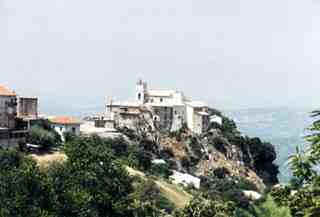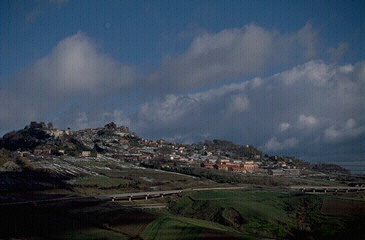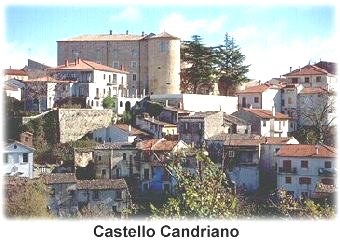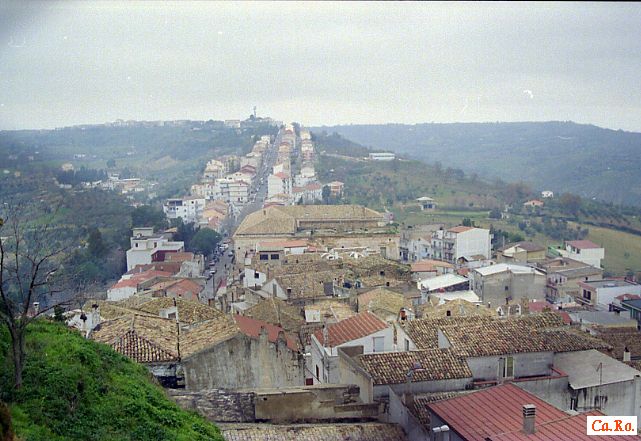| Hometowns: 1890 Campania, Italy |
||
|
Immigration Life in Brooklyn Assimilation Research |
1890-1910
Southern Italy: The Pomaricos
Castelvetere sul Calore Southern Italy in 1890 While Italy had always been a unit geographically, modern Italy came into existence in March 1861 when Cavour proclaimed a united Italian kingdom. Despite the new kingdom, Italy continued to be regionally oriented and the differences between the north and the south were great. Southern Italy in 1890 had barely improved 30 years after the country was united. Illiteracy was widespread, cholera and malaria killed many, and the industrial revolution had bypassed the agricultural south. Peasants rarely ate meat and often their diet consisted of just rice, bread, pasta or polenta. Taxes from the new central government in 1876 were levied on grinding grain and thus fell heavily upon the poor. Deforestation ravaged the arable land with pockets remaining such as Campania, the fertile region east of Naples. Campania and Agriculture Between 1861 and 1900, ecclesiastical land was broken up as the grip of the church weakened. With this breakup, peasants lost the right to use common land for collecting wood or grazing. Existing landlords bought the land and concentrated their control. A census in 1881 found that for every thousand people living in the countryside there were 46 landowners and 59 peasant proprietors. The majority of people were like my ancestors who were employed for half the year and subject to agricultural slumps that hit in 1873, 1885, 1888, and 1905. The gradual spread of education and the new railways and roads brought the farm laborers in touch with cities and they realized the extent of their poverty. During the extended agricultural depression of the 1800s, strikes and forcible occupation of the land started to increase. Although the taxes were levied on commodities like salt, grain and gambling, there was not a single tax on the wealthy sections of scoiety. When this was attempted during the financial crisis of 1893, the rich revolted, took over the government, and responded by increasing the salt and grain taxes some more. While my relatives lived in a relatively fertile region for Southern Italy, between 1885 and 1910 they started for America leaving behind a difficult agraian life for an unknown urban life abroad. Sant Angelo dei Lombardi, Campania Many of my ancestors came from the town of Sant Angelo dei Lombardi or the neighboring town of Torella. My dentist in Connecticut is a Pomarico as well and he says his family comes from Benvenuto, not far from Sant Angelo. Below is a list of people and immigration dates. Farm Laborers & sons
Torella Lombardi is the town next to Sant Angelo. I am in the (slow) process of copying the vital records for these two towns. Click here for Sant Angelo dei Lombardi and Torella Lombardi vital records.
Sant Angelo dei Lombardi More info on Sant Angelo dei Lombardi Information on the town and US immigrants from Sant Angelo dei Lombardi The town is located at 850 metres above the sea level. The name derives from the fact that the town was built by the Longobards. It became an episcopal town at the end of the XI century by Gregorio VII and Urbano XVI. It subsequently became a feud held by the Caracciolo, Carafa and the Imperiali. It was destroyed by the earthquakes of 1664 and 1980. The historical center is typically medieval. The last earthquake damaged some noble palaces, the cathedral and the castle. The medieval village was at the foot of the castle that dates back to the first half of the X century. It was modified during the Norman-Suabian period and subsequently became a noble residence. The most important modifications were done by the Caracciolo in the XVI century and by the prince Placido Imperiale in 1768. This last fact is mentioned in an inscription that was near the portal of the palace. The castle became a court and a jail in 1862. The castle was the seat of the notary archive and of the offices of the magistrature in the last years. S. Angelo dei Lombardi is formed by the hamlets of Croci S. Rocco, S. Bartolomeo and S. Guglielmo del Goleto. MEDIEVAL ABBEY OF GOLETO The Benedectine Abbey of Goleto is in the Ofantina valley a few kilometers from S.Angelo dei Lombardi. The Goleto, the most interesting medieval monument of the high Irpinia, was founded by S.Guglielmo of Vercelli in the first half of the XII century. He built a great cenobio for menand women (1133) in a place called "lu Gallitu" that Ruggiero S. Severino, Lord of Monticchio dei Lombardi, donated him. There were ruins of a temple dedicated to the sun god and ruins of roman thermal baths. The two families formed a community governed by an abbess who became the high authority of Goleto. The abbey was formed by the monastery, the superior church, the inferior church, the cemetery, a tower and a castle. The monastery was composed by two buildings one for men one for women. The superior church called chapel of S.Luca was the oratory of the nuns. It has a romanic style and the way to get into is an external stairs called "holy stairs". The abbey of Goleto, one of the most famous of the South of Italy, was an economic and religious power during the Middle age. Giulio II abolished the female monastery (1505) and annexed it to the one of Montevergine. The French law abolished the monastery (1807) and the relics of S. Guglielmo were transported to the abbey of Montevergine while the people of Nusco, Lione and S. Angelo took the land and the fittings. There is an arch on the entrance door with an inscription " in tempore domini marine abbatisse it domini magistri-P", and two rampant lions with ancient fragment on the side walls. There is another inscription on the entrance door "AB IN GAR.D.A.M.CCQIIIN DIC.V.X.II.N.ED.F. ABATO FEBRONIAC.T. OPAIS ABBA". LONGOBARD CASTLE It is located in Andrea square and has some Byzantine archeological finds. CATHEDRAL OF THE XI CENTURY The cathedral was rebuilt in the XVI century. It has a Renaissance style with three naves and a marble portal. There is a cemetery of the XVII century and a square belltower. It was seriously damaged by the earthquakes. It has a beautiful facade with a stone portal of the XVIII century.
Castello Candriano in Torella Birthplace of Pasquale Pomarico and his siblings. Located on the next hilltop across from S. Angelo dei Lombardi The origins of the town date back to the period of the disagreement between the Longobard princedoms of Benevento and Salerno, around the year 850. The princedom of Salerno was defended by a little fortress called Turrella, from which derives Torella. The name "dei Lombardi" was added after the italian unity to distinguish it from the other one of "del Sannio". The oldest feudal lords of the town belonged to the Saraceno family. Torella passed to the Caracciolo family (XV century) who became princes in 1638. CANDRIANO CASTLE A big medieval castle called "Ruspoli" from the name of the last prince who held it in the first half of this century. It is held by the town now. It was transformed into an elegant noble residence by the Caracciolo family during the XV, XVI and XVII centuries. Giovanna Caracciolo, daughter of Giuseppe and poetess was born in the castle in the XVII century. It is now being restored after the earthquake of 1980. It will the seat of the city hall offices and of the cultural associations.
View of Pomarico While a group of Pomaricos lived in Campania in 1890, the family name comes from the town of Pomarico located in Basilicata, a bt further south in hillier country. Pomarico, Basilicata, MT-077 Town located southwest of Matera |
![]()



